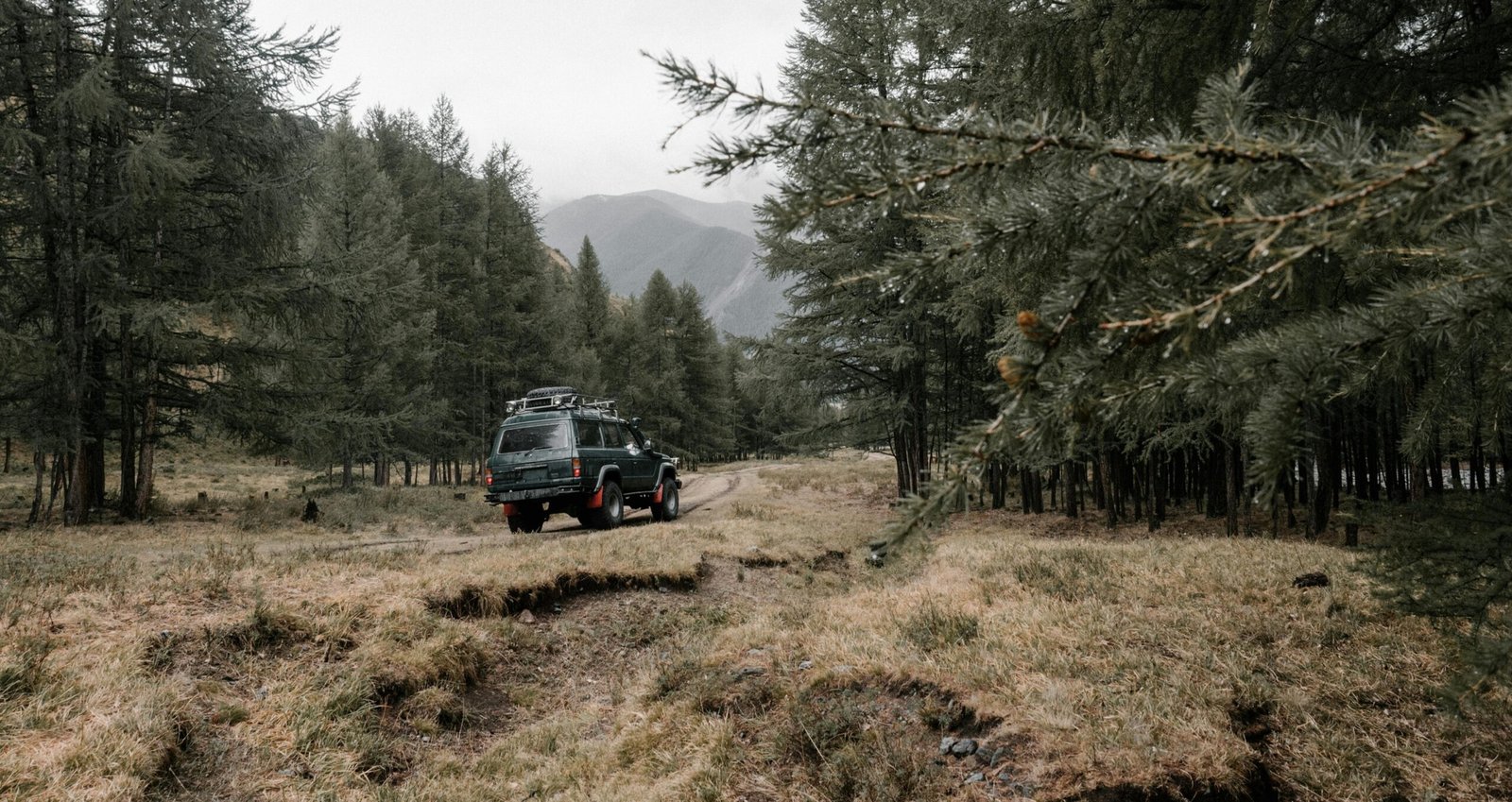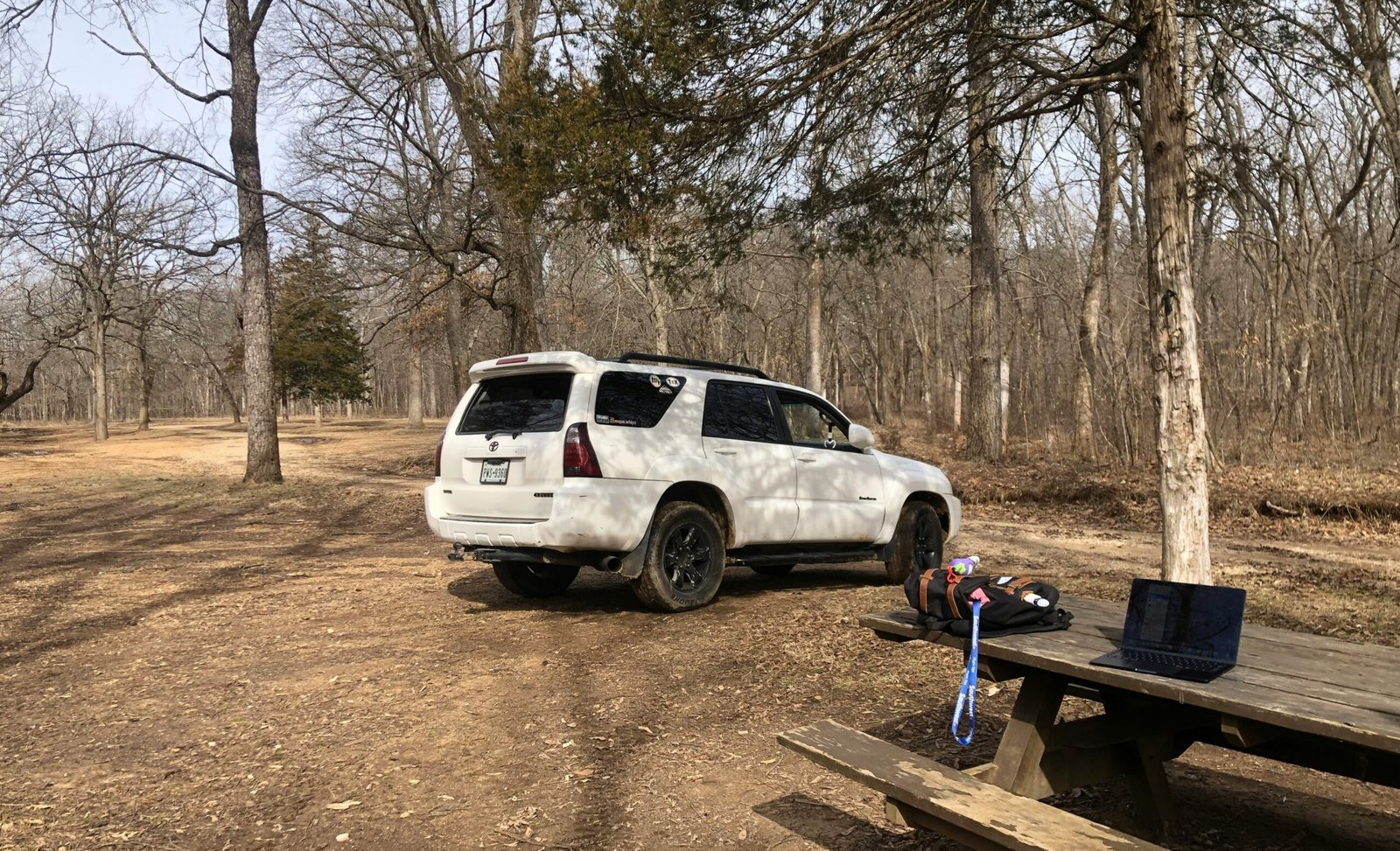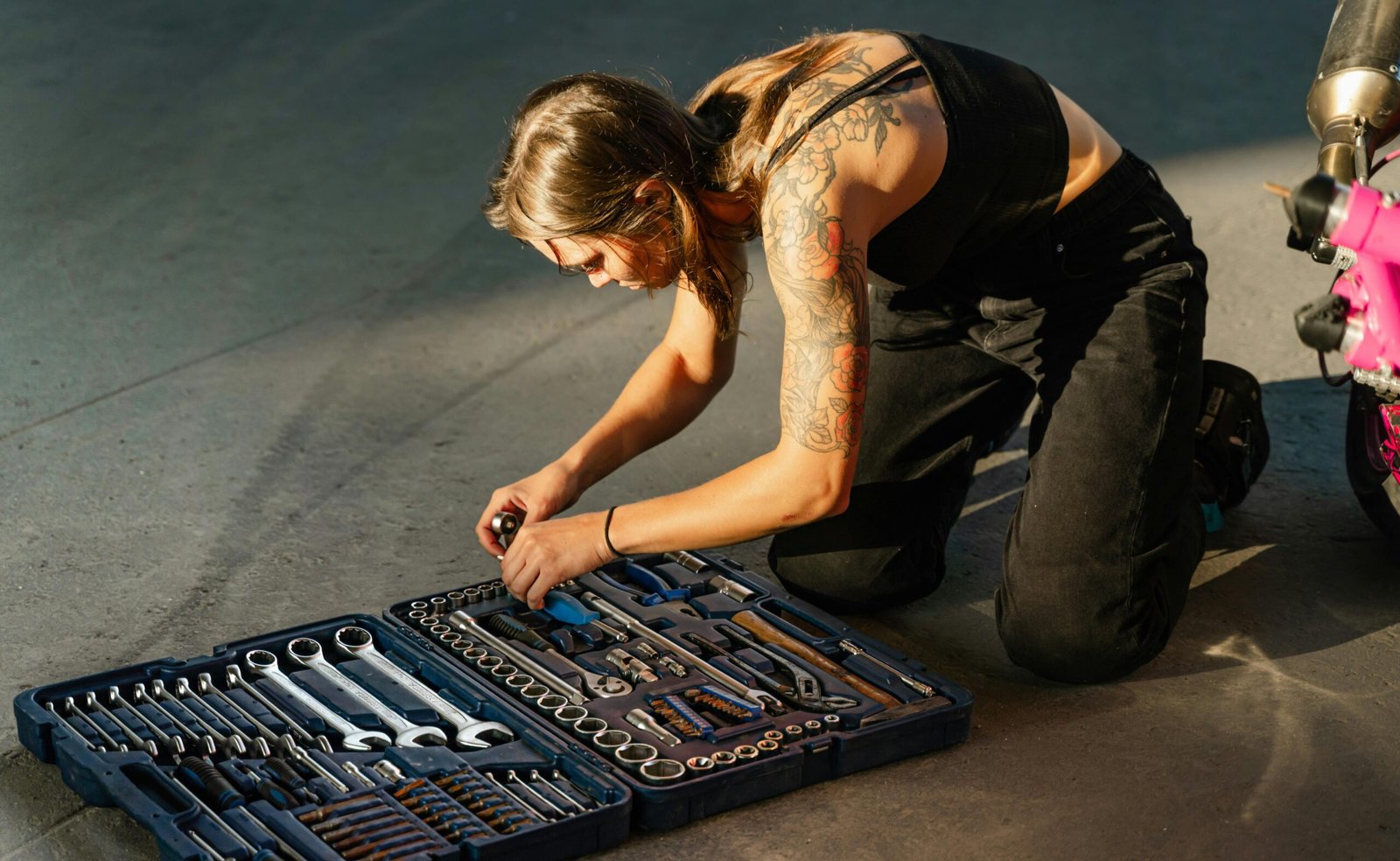Nothing kills the pre-trip buzz faster than crawling under your rig on a damp driveway, trying to torque suspension bolts while mud drips in your face. A four-post lift flips that script completely. You simply drive on, hit a button, and every fastener, fluid fitting, and frame weld is brought to eye level.
Forget about dealing with wobbly jack stands or guesswork. This guide will show why a four-post lift is the safest, fastest way to get any adventure vehicle trail-ready. We will cover setup and the most critical under-vehicle checkpoints before you head for the horizon.
Why a Four-Post Lift Is the Ultimate Adventure-Prep Tool
Four-post lifts provide an unmatched combination of stability, access, and safety, making them ideal for heavy, long-wheelbase adventure vehicles. Their core benefits are built around making under-vehicle work efficient and secure.
Key advantages make these lifts a superior choice for serious vehicle preparation.
- Stability for long wheelbases: A Sprinter with a 170-inch wheelbase, a Class C E-450, or a long-bed Tacoma with a camper shell can all sit solidly on a four-post’s runways without teetering. The vehicle is supported by its wheels, just as it is on the road, providing a firm and stable platform for any task.
- Full under-vehicle visibility: With the vehicle's weight on the wheels, the suspension geometry stays at its natural ride height. This is crucial for accurate brake checks, bushing inspections, and torque procedures that require the suspension to be loaded.
- Drive-on convenience: Forget crawling on the floor to position lift pads or jack stands. With a four-post lift, you simply align the runways, drive on, chock the rear wheels, and lift the vehicle to a comfortable working height in seconds.
- ALI-certified safety features: Reputable four-post lifts include redundant cable locks and mechanical ladders. Once the locks engage, the rig cannot drop, and many of HeavyLift Direct's heavy-duty 4-post car lifts include these systems.
| Key Insight: The core advantage of a four-post lift is its ability to hold the vehicle at ride height, allowing for accurate torque specs and suspension checks under its own weight, a critical factor for long-wheelbase adventure rigs. |
Setting Up Your Four-Post Lift Bay
Proper bay preparation is essential for safe and effective lift operation. Before installation, confirm your space meets the necessary requirements.
Pre-installation Checklist
Before installation, confirm your space meets these necessary requirements:
- Ceiling height: A minimum of 12 feet (3.7 m) allows you to raise most Class B rigs to the lift’s full stroke.
- Power supply: Most lifts require a 220V single-phase power source. Always check the breaker size specified by the lift manufacturer.
- Floor thickness: A standard 4-inch (100 mm) slab of 3,000-psi concrete is typical. If your rig tops 14,000 lbs (6,350 kg), confirm your floor's adequacy with a structural engineer.
- Compliance paperwork: Keep your ALI/ANSI compliance and inspection records handy for insurance and safety verification.
Essential Tools
Having the right tools makes every job easier. Key items include a 1/2-inch drive torque wrench (30–250 ft-lb range), a cordless impact gun for speed, and good task lighting. Also, keep wheel chocks and drip pans readily available for safe operation.
Safety First
Always prioritize safety by wearing eye protection, gloves, and hearing protection when using pneumatic tools. Critically, never work beneath a vehicle unless all four mechanical safety locks are fully engaged and you have visually confirmed they are secure.
| Important: Never work beneath a lifted vehicle until you have visually confirmed that all four mechanical safety locks are fully engaged. This single check is the most critical safety step in using any four-post lift. |
Trail-Ready Checklist You Can Tackle on a Four-Post Lift
With your vehicle at a comfortable working height, you can efficiently run through a comprehensive pre-trip inspection.
- Inspect & Maintain Your Suspension: Look for split bushings, leaking shocks, or bent control arms. A four-post lift allows you to torque critical fasteners at ride height, which is essential for proper function. For example, Sprinter front lower control arm bolts should be torqued to 177 ft-lb (240 N·m).
- Check Your Tires & Brakes: Spin each wheel to feel for bearing play. Inspect brake rotors for heat spots and pads for uneven wear, ensuring they meet the minimum thickness (often 0.12 in / 3 mm). Set tire pressures for your expected load, which is often around 50 psi for a fully loaded van.
- Optimize Your Load for Performance: From underneath, you can easily verify that the mounting brackets for all storage boxes are secure. Ensure heavy items are positioned forward of the rear axle to maintain stability.
- Upgrade Your Lighting for Safety: With the vehicle perfectly level on the lift, you can accurately aim new LED light bars. A proper setup ensures the beam cutoff falls just below your headlight high-beam line at 25 feet (7.6 m) ahead.
- Essential Recovery Gear & Emergency Prep: Easily mount winch plates, rock sliders, or skid plates. A lift provides clear access to torque heavy-duty mounting bolts correctly, such as Grade 8 winch bolts to 75 ft-lb (102 N·m).
- Don’t Forget Routine Maintenance: Perform routine tasks like draining and refilling the differential fluid, checking for metal flakes on the magnetic plug. Grease slip yokes and U-joints until clean grease purges from the seals.
| Pro Tip: Always torque suspension fasteners at ride height with the vehicle's weight on the wheels. This prevents bushing preload and ensures components function correctly on the trail, a task made simple with a four-post lift. |
How to Choose the Right Lift Kit for Off-Road Adventures
Choosing between a body lift and a suspension lift depends on your goals. A body lift uses pucks to raise the vehicle's body, allowing for larger tires without changing driveline angles. This option typically provides one to two inches of lift.
A suspension lift, however, provides extra damper travel, which is ideal for handling corrugated fire roads and more aggressive terrain. Match your kit height to your desired tire size and ensure your vehicle will still clear your garage door opening, especially with a roof rack installed.
Popular Heights
Consider these common configurations for different adventure rigs:
- Sprinter 4×4: A 1.5-inch suspension spacer is popular for keeping CV angles close to stock.
- E-350 Cutaway: A 2-inch coil-spring conversion can accommodate taller 35-inch tires.
- Tacoma: A 3-inch front and 2-inch rear lift is a common sweet spot before requiring new upper control arms (UCAs).
DIY vs. Pro: What Does a Lift-Kit Installation Actually Cost?
A four-post lift significantly reduces labor time, which impacts the overall cost of an installation, whether you do it yourself or hire a professional.
| Cost Line | DIY (Own Four-Post) | DIY (Rent Four-Post) | Pro Shop |
|---|---|---|---|
| Parts (Bilstein/OME kit) | $1,300 | $1,300 | $1,300 |
| Lift purchase or rental | $0 (already owned) | $200/day | $0 |
| Specialty tools | $150 | $150 | $0 |
| Alignment | $120 | $120 | $120 |
| Labor time | 8 hrs personal | 8 hrs personal | 6 hrs shop @$140/hr = $840 |
Owning or renting time on a four-post saves roughly three hours compared to working with floor jacks. This is thanks to the elimination of repositioning and jack-stand juggling. If you install multiple modifications per year, the return on investment for owning a lift becomes apparent quickly.
Step-by-Step Lift-Kit Installation (High-Level)
- Stage all parts on the lift runways at waist height to reduce fatigue and keep everything organized.
- Raise the rig just enough to unload the suspension, then lower it onto the mechanical locks so the wheels are still carrying the vehicle's weight.
- Replace the shocks, springs, spacers, or control arms as required by the kit. Torque all fasteners to spec while the wheels are down to avoid preloading the bushings.
- Raise the lift fully to check for adequate brake line slack and reinstall the wheels.
- Drive the vehicle off the lift and directly to an alignment shop. Afterward, perform a 25-mile shakedown drive to settle the new components, then re-torque all fasteners.
How to Maintain Your Lift Kit for Long-Term Performance
Proper maintenance ensures your investment continues to perform safely for years. Re-torque all suspension hardware after the first 500 miles and then again at every oil change.
If your kit uses polyurethane bushings, grease them with silicone paste twice a year to prevent squeaking. Regularly inspect CV boots for cracks and shocks for any oil mist to prevent a trailside breakdown.
| Pro Tip: Mark your calendar to re-torque all suspension hardware after the first 500 miles on a new lift kit, and then again at every oil change. This simple habit prevents loose components and ensures long-term trail safety. |
Four-Post Lift Ownership: Cost, Maintenance, and ROI
Quality units with a 14,000-lb rating typically cost between $6,500 and $7,800. Annual maintenance, including cable inspection and hydraulic fluid changes, averages around $150–$200 in parts.
Since a four-post lift can also be used as a storage lift, many owners recoup their investment by stacking seasonal vehicles, freeing up valuable garage floor space.
Compliance & Safety Standards You Can’t Ignore
The ANSI/ALI ALCTV certification is the gold standard for automotive lift safety. Always look for the gold ALI label on any lift you consider and insist on annual third-party inspections for your own equipment.
Follow fundamental safety rules like always engaging mechanical locks and never exceeding the rated weight or wheelbase envelopes.
| Important: Prioritize safety above all else by choosing a lift with the gold ANSI/ALI ALCTV certification label. Uncertified lifts may not meet mandatory safety standards, putting both you and your vehicle at significant risk. |
The Road Forward
A four-post lift transforms under-vehicle preparation from a knuckle-busting chore into a one-afternoon confidence builder. You can see everything clearly, torque every bolt correctly, and roll into trail season knowing your rig is mechanically dialed.
The payoff is always safer travels and more miles on the trail before the next wrenching session. Whether you invest in a unit for your own shop, rent bay time, or visit a pro who uses one, the benefits are clear.
Consider scheduling your first lift session before your next adventure window opens. Your future self will thank you for the ease and confidence it provides.




